xiaomi 15 ultra: design impressionante eleva o padrão dos smartphones topo de linha
xiaomi 15 ultra impressiona com construção premium—pena que a disponibilidade global não acompanha o sucesso

- Xiaomi 15 Ultra: análise, preço, recursos e onde comprar
- Análise do Xiaomi 15 Ultra: design e características da tela
- Análise e recursos da câmera do Xiaomi 15 Ultra
- Análise de desempenho e benchmarks do Xiaomi 15 Ultra
- Análise da bateria e desempenho do Xiaomi 15 Ultra
- Análise de software e recursos do Xiaomi 15 Ultra
- Análise do Xiaomi 15 Ultra e veredicto final
Veredicto preliminar
Prós
- + Qualidade de câmera excepcional.
- + Desempenho ultrarrápido.
- + Design clássico e atemporal.
- + Bateria que dura o dia todo.
- + Tela vívida e impressionante.
Contras
- - Indisponível no Brasil.
- - Preço elevado.
- - Os recursos de IA precisam de melhorias.
Nossa equipe dedica inúmeras horas analisando e avaliando os mais recentes produtos, serviços e aplicativos para ajudar você a fazer as melhores escolhas. Saiba mais sobre nosso processo de testes, análise e avaliação.
A Xiaomi acaba de lançar dois novos smartphones que prometem agitar o mercado: o Xiaomi 15 e o Xiaomi 15 Ultra, apresentados durante o Mobile World Congress, em Barcelona. Embora esses aparelhos possam não chegar oficialmente ao Brasil, ambos trazem recursos impressionantes — com destaque para a versão Ultra, que se sobressai em desempenho e design.
O Xiaomi 15 Ultra vem equipado com especificações de ponta. Conta com câmeras avançadas de nível profissional — incluindo uma impressionante lente telefoto de 200 MP —, bateria de longa duração para uso intenso e o moderno chipset Snapdragon 8 Elite, garantindo performance de alto nível. O software personalizado da Xiaomi também é um diferencial, proporcionando uma experiência única em relação ao Android tradicional.
Confira a análise completa abaixo e entenda por que o Xiaomi 15 Ultra é uma excelente escolha. Com tela de altíssima qualidade, design inovador e elegante, câmeras excepcionais e bateria duradoura, este smartphone se destaca em todos os quesitos — mesmo com disponibilidade restrita em algumas regiões.
Xiaomi 15 Ultra: análise, preço, recursos e onde comprar
A Xiaomi anunciou que o Xiaomi 14 Ultra será lançado em 4 de março. No entanto, o aparelho não deve chegar ao mercado dos Estados Unidos. Em vez disso, será lançado na Europa e provavelmente também no Reino Unido. O preço inicial será de R$ 7.900 (€1.599), igual ao modelo anterior. Embora o valor oficial no Reino Unido ainda não tenha sido confirmado, espera-se que permaneça em £1.299.
Análise do Xiaomi 15 Ultra: design e características da tela

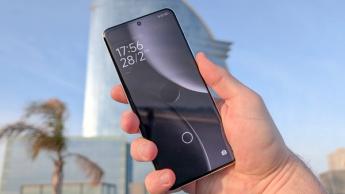
O Xiaomi 15 Ultra conta com uma impressionante tela AMOLED de 6,73 polegadas, com resolução QHD+ e taxa de atualização adaptativa LTPO de 1 a 120 Hz, proporcionando imagens vibrantes e extremamente fluidas. A tela é compatível com HDR10+ e Dolby Vision, alcança até 3.200 nits de brilho e possui um sensor de impressão digital ultrassônico integrado sob o display.
Construído com a segunda geração do Shield Glass da Xiaomi, o 15 Ultra oferece durabilidade aprimorada, sendo até 16 vezes mais resistente a quedas em comparação com a geração anterior. Outras características de resistência incluem certificação IP68 contra água e poeira, estrutura de alumínio de alta resistência e traseira em fibra de vidro de padrão aeroespacial, tornando o aparelho robusto sem adicionar peso desnecessário.
Dependendo da configuração, o smartphone pesa entre 226 e 229 gramas. Embora não seja mais leve que alguns concorrentes topo de linha, passa uma sensação de solidez e qualidade ao segurar, sem ser excessivamente pesado. Com 9,1 mm de espessura, não é o aparelho mais fino do mercado, mas isso não compromete seu apelo geral.
A edição Silver Chrome se destaca pelo design inspirado em câmeras clássicas, com acabamento em couro sintético que adiciona um toque nostálgico. O módulo de câmeras é ainda proeminente, mas o visual geral é sofisticado e elegante. A tela curva pode não agradar a todos, mas contribui para a estética moderna do dispositivo.
Esse tipo específico de design de tela pode ter perdido popularidade entre os principais smartphones globais, mas está fazendo sucesso no mercado chinês. Enquanto muitos fabricantes de celulares utilizam telas curvas para reduzir as bordas, o Xiaomi 15 Ultra apresenta uma borda visivelmente grossa ao redor das extremidades — um pouco mais espessa do que as bordas já consideráveis do meu Pixel 9 Pro, especialmente nos cantos.
Apesar disso, a tela oferece uma experiência visual impressionante. Seja rolando aplicativos ou navegando pela Google Play Store, o display é vibrante e agradável. Assistir a filmes em plataformas de streaming também é muito satisfatório, com imagens nítidas e cores vivas. No entanto, como na maioria dos smartphones, você pode notar barras pretas extras ao assistir filmes, o que pode ser um pouco incômodo.
Para aproveitar ao máximo a visualização, é importante posicionar o aparelho no ângulo certo. Embora o Xiaomi 15 Ultra ofereça excelente brilho, ver a tela de lado em ambientes muito iluminados pode fazer com que ela reflita como um espelho. Olhar diretamente para a tela normalmente proporciona uma visualização clara e imersiva.

Análise e recursos da câmera do Xiaomi 15 Ultra
O Xiaomi 15 Ultra conta com um impressionante conjunto de quatro câmeras traseiras, além de uma câmera frontal para selfies. Na parte de trás, há três lentes de 50MP — principal, ultrawide (ultra grande-angular) e uma lente telefoto "flutuante" com zoom óptico de 3x — todas entregando fotos em alta resolução. O grande destaque é a lente telefoto periscópica, que possui um sensor de impressionantes 200MP e zoom óptico de 4,3x. Já a câmera de selfie vem equipada com um sensor confiável de 32MP.
Embora as quatro câmeras traseiras contem com ópticas avançadas, a câmera frontal não possui esse diferencial. Vale lembrar que as especificações contam só parte da história. Para avaliar o desempenho do Xiaomi 15 Ultra em situações reais, ele foi comparado diretamente ao Google Pixel 9 Pro, um dos principais concorrentes entre os melhores celulares Android para fotografia.
Os testes começaram com a lente principal, fotografando uma escultura na orla de Barcelona. A imagem do Xiaomi ficou visivelmente mais escura que a do Pixel, mas apresentou um campo de visão um pouco mais amplo. Ao aplicar zoom, o Xiaomi 15 Ultra revelou mais detalhes, superando o Pixel 9 Pro, cujas fotos ficaram mais borradas e menos nítidas — especialmente em rostos, texturas da madeira e textos.
Em ambientes internos, os resultados mudaram. O Xiaomi 15 Ultra registrou fotos mais claras, porém um pouco mais esbranquiçadas em comparação ao Pixel 9 Pro, especialmente nos fundos das imagens. Isso deixou os reflexos menos definidos, mas o objeto principal, como uma lata, permaneceu nítido e claro, até mais do que no Pixel.
Nas fotos em ultrawide, como as do hotel W Barcelona, as diferenças de iluminação foram mínimas. No entanto, o Pixel 9 Pro capturou cores do céu mais próximas da realidade, enquanto o Xiaomi 15 Ultra entregou uma imagem muito mais nítida, com mais detalhes e menos neblina ao dar zoom.
Ao testar a lente telefoto na ampliação padrão, o Xiaomi 15 Ultra novamente produziu fotos mais escuras que o Pixel 9 Pro, cujas imagens mais claras tendiam a ficar superexpostas e com poucos detalhes. Apesar de as fotos telefoto do Xiaomi capturarem mais detalhes, nenhum dos dois aparelhos teve resultados excepcionais nessa configuração.
Com zoom de 2x, as imagens do Xiaomi continuaram escuras e perderam alguns detalhes esperados, enquanto o Pixel 9 Pro teve ainda mais dificuldades com nitidez e superexposição. Ao ampliar para 5x, ambos os aparelhos apresentaram melhorias visíveis. O Xiaomi 15 Ultra ainda manteve tons mais escuros, mas conseguiu um melhor equilíbrio de cores e menos superexposição que o Pixel, tornando detalhes como gaivotas voando mais perceptíveis.
O Xiaomi 15 Ultra também se saiu bem nas selfies, entregando imagens quentes e nítidas, com detalhes como fios de cabelo bem definidos. No entanto, o Pixel 9 Pro conseguiu uma representação mais fiel dos tons de pele e dos traços faciais, incluindo sardas e poros, resultando em uma imagem mais realista.
No modo Retrato, ambos os smartphones tiveram resultados semelhantes. O Xiaomi 15 Ultra trouxe tons mais quentes, mas deixou passar algumas texturas finas da pele que o Pixel 9 Pro conseguiu captar. Ambos oferecem um bom desfoque de fundo (bokeh), sendo que o Pixel intensifica um pouco mais esse efeito, ideal para quem prefere esse tipo de acabamento.
Na fotografia em baixa luz, o desempenho dos dois aparelhos foi bastante próximo. O Xiaomi 15 Ultra tende a escurecer mais as cores, mas o seu modo noturno mantém as imagens suficientemente iluminadas. Ao analisar de perto, o Pixel 9 Pro apresentou detalhes mais nítidos, como pichações em pilares, em comparação ao Xiaomi.
De modo geral, o Xiaomi 15 Ultra se destaca pelo excelente conjunto de câmeras, frequentemente entregando cores mais quentes e realistas. Ele também evita alguns dos problemas de processamento de imagem vistos em modelos anteriores. Apesar da tendência para fotos mais escuras e da performance da lente telefoto poderem melhorar — especialmente considerando o sensor de 200MP — o Xiaomi 15 Ultra continua sendo uma ótima opção para quem busca um smartphone potente para fotografia.
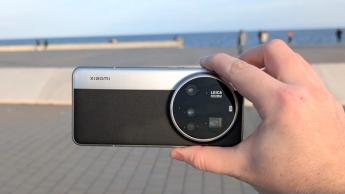
Análise de desempenho e benchmarks do Xiaomi 15 Ultra
Assim como muitos dos principais smartphones Android lançados este ano, o Xiaomi 15 Ultra vem equipado com o chipset Snapdragon 8 Elite e 16 GB de RAM. Essa combinação poderosa garante um desempenho impressionante, especialmente em tarefas que exigem alto poder de processamento e gráficos avançados.
Nos testes de benchmark, o Xiaomi 15 Ultra apresenta resultados sólidos, dentro da média entre os aparelhos equipados com Snapdragon 8 Elite. No desempenho single-core, ele marcou 2.986 — um pouco abaixo de alguns concorrentes, mas acima de outros. Já nas tarefas multi-core, o 15 Ultra alcançou 9.064 pontos, ficando próximo de outros dispositivos Android topo de linha, embora alguns rivais com chipsets aprimorados tenham se saído um pouco melhor.
O desempenho gráfico é forte, mas não chega ao topo quando comparado com modelos similares. No teste Solar Bay Unlimited do 3DMark, o Xiaomi 15 Ultra atingiu 10.100 pontos, ficando um pouco atrás de outros modelos flagship Android. Sua média de 38,4 fps também ficou abaixo da de alguns concorrentes, mas ainda superou certos aparelhos rivais em gráficos e taxa de quadros.
Para edição de vídeo, o Xiaomi 15 Ultra se destaca. Ele converteu um vídeo em 4K para 1080p em apenas 48 segundos, sendo mais rápido que vários outros smartphones topo de linha nessa categoria, embora ainda fique atrás de um concorrente líder conhecido pela velocidade no processamento de vídeos.
Nos jogos, o Xiaomi 15 Ultra oferece uma experiência suave e responsiva, com jogabilidade fluida e sem travamentos perceptíveis. A maioria das ações nos jogos ocorre sem problemas, embora pequenas quedas de desempenho possam ocorrer em cenas com muitos elementos distantes. Um ponto positivo é que o aparelho se mantém frio mesmo em longas sessões de jogo, proporcionando conforto durante o uso.
No geral, o Xiaomi 15 Ultra entrega um desempenho confiável de flagship, sendo uma excelente escolha para quem busca velocidade, eficiência e uma boa experiência em jogos no smartphone Android.
Análise da bateria e desempenho do Xiaomi 15 Ultra
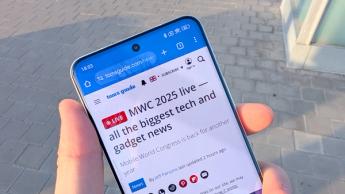
O Xiaomi 15 Ultra conta com uma poderosa bateria de 5.410 mAh, oferecendo uma autonomia impressionante até mesmo em comparação com outros smartphones topo de linha. No entanto, a capacidade da bateria é apenas parte da história — o que realmente importa é quanto tempo o aparelho aguenta longe da tomada. Em nosso teste de bateria, que consistiu em transmitir um vídeo do YouTube em resolução 1080p por três horas, com o brilho da tela ajustado para 50%, o Xiaomi 15 Ultra perdeu apenas 11% de carga. Para efeito de comparação, o Xiaomi Mix Fold 4 perdeu 14% e o Google Pixel 9 Pro perdeu 21% nas mesmas condições. Isso demonstra como a bateria de grande capacidade, aliada ao processador Snapdragon 8 Elite, eficiente em consumo de energia, proporcionam um excelente desempenho.
Na hora de recarregar, o Xiaomi 15 Ultra suporta carregamento rápido de 90W via cabo e 80W sem fio — desde que você utilize carregadores compatíveis. Utilizando um carregador Hypercharge de 67W, a bateria chegou a 46% em apenas 15 minutos e a 81% em 30 minutos. As velocidades de carregamento atingiram o pico de aproximadamente 61,9W, normalmente variando entre 25W e 40W durante os testes. Com um carregador ainda mais potente, é possível alcançar tempos de recarga ainda menores. Vale lembrar que o adaptador de tomada não vem incluso na caixa, sendo necessário adquiri-lo separadamente.
No geral, o Xiaomi 15 Ultra se destaca pela bateria de longa duração e pela recarga super-rápida, tornando-se uma excelente escolha para quem valoriza desempenho confiável e praticidade no dia a dia.
Análise de software e recursos do Xiaomi 15 Ultra
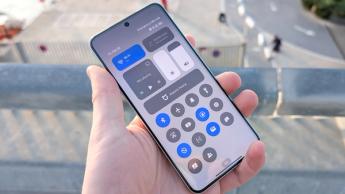

O Xiaomi 15 Ultra roda o HyperOS 2, que é baseado no Android 15. A Xiaomi promete 4 gerações de atualizações do sistema Android e 6 anos de atualizações de segurança para este aparelho. Embora esse suporte não seja tão extenso quanto os 7 anos oferecidos por alguns concorrentes, ainda supera muitos outros fabricantes de celulares Android.
O HyperOS 2 traz uma interface de usuário que lembra bastante o iOS da Apple, especialmente com seus menus suspensos divididos e um layout no estilo Central de Controle. Esse design se assemelha mais ao iOS do que ao menu tradicional de Configurações Rápidas do Android.
Apesar dessas inspirações no iOS, o HyperOS 2 mantém a essência do Android, incluindo recursos como a barra Descobrir e o layout familiar do menu de configurações. No entanto, oferece uma aparência e experiência únicas, diferenciando-se de interfaces como o Pixel Launcher do Google ou a One UI da Samsung.
A Xiaomi continua apostando em inteligência artificial, e o 15 Ultra vem equipado com uma ampla variedade de ferramentas de IA integradas, chamadas coletivamente de HyperAI. Você também encontra recursos familiares do Google, como o assistente Gemini AI e o Circle to Search. Além disso, o 15 Ultra oferece três meses gratuitos de teste do Gemini Advanced.
Embora esses recursos sejam semelhantes aos encontrados em outros smartphones Android, pode surgir a dúvida se o HyperAI realmente traz algo exclusivo.
Um desafio do pacote HyperAI é que, assim como em muitos celulares com IA, pode ser complicado localizar essas funções. Elas nem sempre são fáceis de encontrar e estão espalhadas pelos menus do aparelho. Por exemplo, recursos como legendas automáticas por IA ficam escondidos como opções extras no Centro de Controle, o que faz com que passem despercebidos, a menos que você procure por dicas na internet. Isso pode dificultar o acesso e o aproveitamento total das capacidades de IA pelos usuários.

As legendas geradas por IA tiveram resultados variados durante a minha experiência. Em alguns momentos, funcionaram surpreendentemente bem, como ao traduzir do francês para o inglês. Porém, em outros casos — como ao assistir à dublagem coreana de Round 6 — capturaram apenas algumas palavras, tornando difícil acompanhar. Apesar de esses recursos serem bastante úteis, é melhor manter expectativas realistas. Além disso, prepare-se para ler rápido, já que a janela das legendas é bem pequena.
Por outro lado, as ferramentas de edição de imagem com IA são muito mais fáceis de encontrar e usar. Esses recursos são parecidos com os encontrados em aplicativos populares de edição de fotos. No geral, funcionam muito bem. Por exemplo, a expansão de imagem faz um bom trabalho ao recriar cenários, como o meu setup de mesa atual, mesmo que não seja perfeito. Já a ferramenta de apagar objetos não remove de fato os itens do quadro — normalmente, ela apenas transforma o objeto em outra coisa.

O boneco do Android na minha mesa foi transformado em um bule de chá verde, enquanto as latas de bebida ao lado do meu notebook viraram pequenos discos de metal. Isso está longe do ideal — ao utilizar o recurso de remoção de objetos, os itens indesejados deveriam ser eliminados completamente. Da mesma forma, o Magic Sky às vezes tem dificuldade para identificar o céu, o que é um problema significativo para uma ferramenta criada para melhorar imagens do céu.
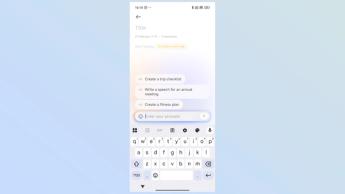
As ferramentas de escrita com IA funcionam exatamente como você espera. É fácil acessar uma barra de chat pelo aplicativo de teclado e digitar seus comandos para que a IA ajude você. Por exemplo, você pode pedir para ela criar uma lista de compras ou sugerir uma receita, como de lasanha. A IA também pode ajudar a ajustar o tom do seu texto, resumir conteúdos, revisar ou expandir algo que você já escreveu.
Se você pretende usar os recursos de IA no Xiaomi 15 Ultra, é importante manter expectativas realistas. Ainda assim, você sempre pode contar com outras ferramentas úteis, como o Gemini e o Circle to Search, se necessário.
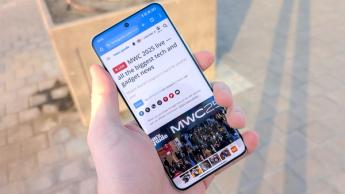
Análise do Xiaomi 15 Ultra e veredicto final
O Xiaomi 15 Ultra se destaca como um smartphone de alto padrão, oferecendo os recursos premium que você espera de um aparelho topo de linha. Sua câmera entrega uma qualidade de imagem impressionante em todas as situações, evitando o uso excessivo de inteligência artificial ou pós-processamento que podem prejudicar as fotos. A bateria também é um ponto forte, garantindo autonomia para o dia todo sem preocupações.
Um dos aspectos mais atraentes do Xiaomi 15 Ultra é o design da edição Silver Chrome. O recorte diferenciado da câmera, inspirado no visual clássico de câmeras fotográficas, adiciona um toque único que diferencia o aparelho dos demais. Essa escolha de design é especialmente interessante para quem não gosta de módulos de câmera exagerados.
No entanto, o aparelho tem algumas limitações. Os recursos de IA são bastante básicos e não trazem grandes inovações, o que faz com que a Xiaomi fique atrás dos concorrentes nesse quesito. Além disso, o visual do sistema, que se inspira em outros sistemas operacionais, pode não agradar a todos, embora alguns usuários possam apreciar essa familiaridade.
Se você se adapta bem ao HyperOS, que é bem diferente das interfaces Android tradicionais como o Stock ou o Pixel Launcher, o Xiaomi 15 Ultra pode ser uma excelente escolha. Só fique atento à disponibilidade, que pode variar de acordo com a região.
